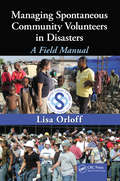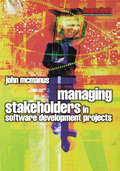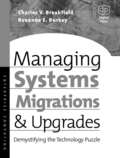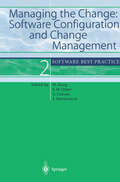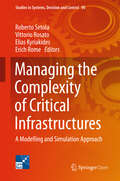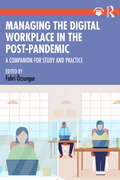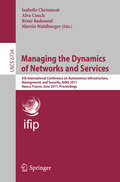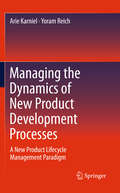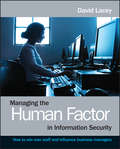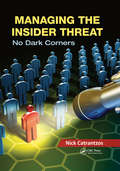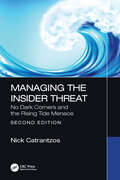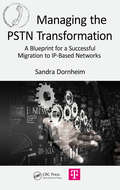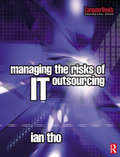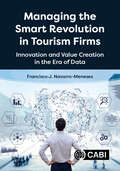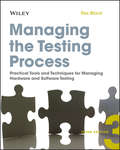- Table View
- List View
Managing Spontaneous Community Volunteers in Disasters: A Field Manual
by Lisa OrloffWhile history has identified a need for improved coordination during emergencies, it has also demonstrated that community volunteers positively impact their neighborhoods during times of crisis. Laying out the rationale and process by which emergency managers, community leaders, and non-governmental aid organizations can effectively collaborate and
Managing Stakeholders in Software Development Projects (Computer Weekly Professional Ser.)
by John McManusAs stakeholder relationships and business in general have become increasingly central to the unfolding of stakeholder thinking, important new topics have begun to take centre stage in both the worlds of practitioners and academics. The role of project management becomes immeasurably more challenging, when stakeholders are no longer seen as simple objects of managerial action but rather as subjects with their own objectives and purposes. This book will aim to explain some of the complexities of project management and managerial relationships with stakeholders by discussing the practice of stakeholder engagement, dialog, measurement and management and the consequences of this practice for reporting and productivity, and performance within project management.
Managing Stakeholders in Software Development Projects
by John McManusAs stakeholder relationships and business in general have become increasingly central to the unfolding of stakeholder thinking, important new topics have begun to take centre stage in both the worlds of practitioners and academics. The role of project management becomes immeasurably more challenging, when stakeholders are no longer seen as simple objects of managerial action but rather as subjects with their own objectives and purposes. This book will aim to explain some of the complexities of project management and managerial relationships with stakeholders by discussing the practice of stakeholder engagement, dialog, measurement and management and the consequences of this practice for reporting and productivity, and performance within project management.
Managing Systems Migrations and Upgrades: Demystifying the Technology Puzzle
by Roxanne Burkey Charles BreakfieldManaging Systems Migrations and Upgrades is the perfect book for technology managers who want a rational guide to evaluating the business aspects of various possible technical solutions. Enterprises today are in the middle of the R&D race for technology leadership, with providers who increasingly need to create markets for new technologies while shortening development, implementation, and life cycles. The cost for the current tempo of technology life cycles is endless change-management controls, organizational chaos, production use of high-risk beta products, and greater potential for failure of existing systems during migration.Burkey and Breakfield help you answer questions such as, "Is the only solution open to me spending more that the industry average in order to succeed?" and "What are the warning signs that tell me to pass on a particular product offering?" as well as "How can my organization avoid the 'technical death marches' typical of the industry?" This book will take the confusion out of when to make shifts in your systems and help you evaluate the value proposition of these technology changes.· Provides a methodology for decision making and implementation of upgrades and migrations· Avoids marketing hype and the "technical herding" instinct· Offers a tool to optimize technology changes for both staff and customers
Managing Technology in Higher Education: Strategies for Transforming Teaching and Learning
by A. W. Bates Albert SangraUniversities continue to struggle in their efforts to fully integrate information and communications technology within their activities. Based on examination of current practices in technology integration at 25 universities worldwide, this book argues for a radical approach to the management of technology in higher education. It offers recommendations for improving governance, strategic planning, integration of administrative and teaching services, management of digital resources, and training of technology managers and administrators. The book is written for anyone wanting to ensure technology is integrated as effectively and efficiently as possible.
Managing Technology in Higher Education: Strategies for Transforming Teaching and Learning
by A. W. Bates Albert SangraUniversities continue to struggle in their efforts to fully integrate information and communications technology within their activities. Based on examination of current practices in technology integration at 25 universities worldwide, this book argues for a radical approach to the management of technology in higher education. It offers recommendations for improving governance, strategic planning, integration of administrative and teaching services, management of digital resources, and training of technology managers and administrators. The book is written for anyone wanting to ensure technology is integrated as effectively and efficiently as possible.
Managing the Change: Software Best Practice 2
by Michael Haug Eric W. Olsen Gonzalo Cuevas Santiago RementeriaC. Amting Directorate General Information Society, European Commission, Brussels th Under the 4 Framework of European Research, the European Systems and Soft ware Initiative (ESSI) was part of the ESPRIT Programme. This initiative funded more than 470 projects in the area of software and system process improvements. The majority of these projects were process improvement experiments carrying out and taking up new development processes, methods and technology within the software development process of a company. In addition, nodes (centres of exper tise), European networks (organisations managing local activities), training and dissemination actions complemented the process improvement experiments. ESSI aimed at improving the software development capabilities of European enterprises. It focused on best practice and helped European companies to develop world class skills and associated technologies to build the increasingly complex and varied systems needed to compete in the marketplace. The dissemination activities were designed to build a forum, at European level, to exchange information and knowledge gained within process improvement ex periments. Their major objective was to spread the message and the results of experiments to a wider audience, through a variety ofdifferent channels. The European Experience Exchange (tUR~X) project has been one ofthese dis semination activities within the European Systems and Software Initiative.~UR~X has collected the results of practitioner reports from numerous workshops in Europe and presents, in this series of books, the results of Best Practice achieve ments in European Companies over the last few years.
Managing the Complexity of Critical Infrastructures: A Modelling and Simulation Approach (Studies in Systems, Decision and Control #90)
by Roberto Setola Vittorio Rosato Elias Kyriakides Erich RomeThis book is open access under a CC BY 4.0 license.This book summarizes work being pursued in the context of the CIPRNet (Critical Infrastructure Preparedness and Resilience Research Network) research project, co-funded by the European Union under the Seventh Framework Programme (FP7). The project is intended to provide concrete and on-going support to the Critical Infrastructure Protection (CIP) research communities, enhancing their preparedness for CI-related emergencies, while also providing expertise and technologies for other stakeholders to promote their understanding and mitigation of the consequences of CI disruptions, leading to enhanced resilience. The book collects the tutorial material developed by the authors for several courses on the modelling, simulation and analysis of CIs, representing extensive and integrated CIP expertise. It will help CI stakeholders, CI operators and civil protection authorities understand the complex system of CIs, and help them adapt to these changes and threats in order to be as prepared as possible for mitigating emergencies and crises affecting or arising from CIs.
Managing the Digital Workplace in the Post-Pandemic: A Companion for Study and Practice
by Fahri 1254 ZsungurManaging the Digital Workplace in the Post-Pandemic provides a cutting-edge survey of digital organizational behaviour in the post-pandemic workplace, drawing from an international range of expertise. It introduces and guides students and practitioners through the current best practices, laboratory methods, policies and protocols in use during these times of rapid change to workplace practices. This book is essential reading for students, researchers and practitioners in business and management. The book draws on global expertise from its contributors while being suitable for class and educational use, with each chapter including further reading, chapter summaries and exercises. Tutors are supported with a set of instructor materials that include PowerPoint slides, a test bank and an instructor's manual. This text covers a wide range of themes in this fast-developing field, including: The effect of the pandemic on the digital workplace Gender and cyberbullying in the context of the digital workplace Digital ergonomics and productivity Digital conflict management
Managing the Digital Workplace in the Post-Pandemic: A Companion for Study and Practice
by Fahri ÖzsungurManaging the Digital Workplace in the Post-Pandemic provides a cutting-edge survey of digital organizational behaviour in the post-pandemic workplace, drawing from an international range of expertise. It introduces and guides students and practitioners through the current best practices, laboratory methods, policies and protocols in use during these times of rapid change to workplace practices. This book is essential reading for students, researchers and practitioners in business and management. The book draws on global expertise from its contributors while being suitable for class and educational use, with each chapter including further reading, chapter summaries and exercises. Tutors are supported with a set of instructor materials that include PowerPoint slides, a test bank and an instructor's manual. This text covers a wide range of themes in this fast-developing field, including: The effect of the pandemic on the digital workplace Gender and cyberbullying in the context of the digital workplace Digital ergonomics and productivity Digital conflict management
Managing the Dynamics of Networks and Services: 5th International Conference on Autonomous Infrastructure, Management, and Security, AIMS 2011, Nancy, France, June 13-17, 2011, Proceedings (Lecture Notes in Computer Science #6734)
by Alva Couch Rémi Badonnel Martin Waldburger Isabelle ChrismentThis book constitutes the refereed proceedings of the 5th International Conference on Autonomous Infrastructure, Management and Security, AIMS 2011, held in Nancy, France, in June 2011. The 11 revised full papers presented together 11 papers of the AIMS PhD workshops were carefully reviewed and selected from numerous submissions. The papers are organized in topical sections on security management, autonomic network and service management (PhD workshop), policy management, P2P and aggregation schemes, and monitoring and security (PhD workshop).
Managing the Dynamics of New Product Development Processes: A New Product Lifecycle Management Paradigm
by Arie Karniel Yoram ReichManaging the Dynamics of New-Product Development Processes merges product-based planning, process modelling, process execution, probabilistic simulations, and simulation based decision-making into one framework called the Dynamic new-Product Development Process. It provides readers with a means of improving the management of product development through enhanced methods and tools that are specifically tailored to the characteristics and challenges of such processes. It calls for a new Product Lifecycle Management paradigm of utilizing the managed product data for management of the product's development process. Within the framework, the methods used are enhanced or modified to fit the new-product development process requirements. Each specific method is exhaustively analyzed, from the basic definition of terms through a description of the state of the art of that topic and its limitations. Then, the method enhancements are illustrated by many examples, and discussed while suggesting further research directions. Finally, the enhanced methods are integrated and demonstrated by a test case. The main two methods described are the design structure matrix (DSM) and Petri nets, which are merged into a novel concept entitled DSM nets. Managing the Dynamics of New Product Development Processes provides algorithms, proofs, and practical examples that can be used for general study of the issues concerned. The main concepts presented are applicable to systems engineering and can be used by practitioners of product development processes, such as designers, product managers, and process managers, as well as developers of process management tools for systems with dynamically changing process structures.
Managing the Human Factor in Information Security: How to win over staff and influence business managers
by David LaceyWith the growth in social networking and the potential for larger and larger breaches of sensitive data,it is vital for all enterprises to ensure that computer users adhere to corporate policy and project staff design secure systems. Written by a security expert with more than 25 years' experience, this book examines how fundamental staff awareness is to establishing security and addresses such challenges as containing threats, managing politics, developing programs, and getting a business to buy into a security plan. Illustrated with real-world examples throughout, this is a must-have guide for security and IT professionals.
Managing the Human Factor in Information Security: How to win over staff and influence business managers
by David LaceyWith the growth in social networking and the potential for larger and larger breaches of sensitive data,it is vital for all enterprises to ensure that computer users adhere to corporate policy and project staff design secure systems. Written by a security expert with more than 25 years' experience, this book examines how fundamental staff awareness is to establishing security and addresses such challenges as containing threats, managing politics, developing programs, and getting a business to buy into a security plan. Illustrated with real-world examples throughout, this is a must-have guide for security and IT professionals.
Managing the Insider Threat: No Dark Corners
by Nick CatrantzosAn adversary who attacks an organization from within can prove fatal to the organization and is generally impervious to conventional defenses. Drawn from the findings of an award-winning thesis, Managing the Insider Threat: No Dark Corners is the first comprehensive resource to use social science research to explain why traditional methods fail aga
Managing the Insider Threat: No Dark Corners
by Nick CatrantzosAn adversary who attacks an organization from within can prove fatal to the organization and is generally impervious to conventional defenses. Drawn from the findings of an award-winning thesis, Managing the Insider Threat: No Dark Corners is the first comprehensive resource to use social science research to explain why traditional methods fail aga
Managing the Insider Threat: No Dark Corners and the Rising Tide Menace
by Nick CatrantzosManaging the Insider Threat: No Dark Corners and the Rising Tide Menace, Second Edition follows up on the success of – and insight provided by – the first edition, reframing the insider threat by distinguishing between sudden impact and slow onset (aka “rising tide”) insider attacks. This edition is fully updated with coverage from the previous edition having undergone extensive review and revision, including updating citations and publications that have been published in the last decade. Three new chapters drill down into the advanced exploration of rising tide threats, examining the nuanced complexities and presenting new tools such as the loyalty ledger (Chapter 10) and intensity scale (Chapter 11). New explorations of ambiguous situations and options for thwarting hostile insiders touch on examples that call for tolerance, friction, or radical turnaround (Chapter 11). Additionally, a more oblique discussion (Chapter 12) explores alternatives for bolstering organizational resilience in circumstances where internal threats show signs of gaining ascendancy over external ones, hence a need for defenders to promote clearer thinking as a means of enhancing resilience against hostile insiders. Coverage goes on to identify counters to such pitfalls, called lifelines, providing examples of questions rephrased to encourage clear thinking and reasoned debate without inviting emotional speech that derails both. The goal is to redirect hostile insiders, thereby offering alternatives to bolstering organizational resilience – particularly in circumstances where internal threats show signs of gaining ascendancy over external ones, hence a need for defenders to promote clearer thinking as a means of enhancing resilience against hostile insiders. Defenders of institutions and observers of human rascality will find, in Managing the Insider Threat, Second Edition, new tools and applications for the No Dark Corners approach to countering a vexing predicament that seems to be increasing in frequency, scope, and menace.
Managing the Insider Threat: No Dark Corners and the Rising Tide Menace
by Nick CatrantzosManaging the Insider Threat: No Dark Corners and the Rising Tide Menace, Second Edition follows up on the success of – and insight provided by – the first edition, reframing the insider threat by distinguishing between sudden impact and slow onset (aka “rising tide”) insider attacks. This edition is fully updated with coverage from the previous edition having undergone extensive review and revision, including updating citations and publications that have been published in the last decade. Three new chapters drill down into the advanced exploration of rising tide threats, examining the nuanced complexities and presenting new tools such as the loyalty ledger (Chapter 10) and intensity scale (Chapter 11). New explorations of ambiguous situations and options for thwarting hostile insiders touch on examples that call for tolerance, friction, or radical turnaround (Chapter 11). Additionally, a more oblique discussion (Chapter 12) explores alternatives for bolstering organizational resilience in circumstances where internal threats show signs of gaining ascendancy over external ones, hence a need for defenders to promote clearer thinking as a means of enhancing resilience against hostile insiders. Coverage goes on to identify counters to such pitfalls, called lifelines, providing examples of questions rephrased to encourage clear thinking and reasoned debate without inviting emotional speech that derails both. The goal is to redirect hostile insiders, thereby offering alternatives to bolstering organizational resilience – particularly in circumstances where internal threats show signs of gaining ascendancy over external ones, hence a need for defenders to promote clearer thinking as a means of enhancing resilience against hostile insiders. Defenders of institutions and observers of human rascality will find, in Managing the Insider Threat, Second Edition, new tools and applications for the No Dark Corners approach to countering a vexing predicament that seems to be increasing in frequency, scope, and menace.
Managing the Paralympics
by Simon Darcy Daryl Adair Stephen FrawleyThis book critically examines the planning, management, and operations of the world’s premier event for Para sport athletes. Noting a lack of research into how these games are planned and managed, the authors of this contributed volume discuss how the Paralympics are essentially different to the Olympics and what this means for their management. Managing the Paralympics explores how the organizers and connected stakeholders effectively organize and deliver the Paralympics, taking into account what has been learned from previous events. Including emergent models of best practice from event management, project management and sport management literature, the book gives an insight into the planning of one of the world’s biggest sporting events that encompasses ten impairment types and multiple sport classes within sports.
Managing the PSTN Transformation: A Blueprint for a Successful Migration to IP-Based Networks
by Sandra DornheimWhile there are many scholarly books and papers that cover the technical issues behind the public switched telephone network (PSTN) migration, few books describe exactly how to manage the migration process economically. Filling this need, Managing the PSTN Transformation: A Blueprint for a Successful Migration to IP-Based Networks reflects the late
Managing the PSTN Transformation: A Blueprint for a Successful Migration to IP-Based Networks
by Sandra DornheimWhile there are many scholarly books and papers that cover the technical issues behind the public switched telephone network (PSTN) migration, few books describe exactly how to manage the migration process economically. Filling this need, Managing the PSTN Transformation: A Blueprint for a Successful Migration to IP-Based Networks reflects the late
Managing the Risks of IT Outsourcing
by Ian ThoThis book shows IT managers how to identify, mitigate and manage risks in an IT outsourcing exercise. The book explores current trends and highlights key issues and changes that are taking place within outsourcing. Attention is given to identifying the drivers and related risks of outsourcing by examining recently published and existing concepts of IT outsourcing. Founded on academic theory and empirical and quantitative information, this book:* Incorporates the complete risk identification and mitigation life cycle* Highlights the concept of core competency * Looks at motivating factors and working relationships of the buyer and supplier* Provides background to understand the risks as a result of ‘human factors’ as defined by the agency theory* Reviews the areas of risk that influence the decision to outsource the IT function* Examines the forces that determine the equilibrium in the risk profiles for the buyer and supplier
Managing the Risks of IT Outsourcing
by Ian ThoThis book shows IT managers how to identify, mitigate and manage risks in an IT outsourcing exercise. The book explores current trends and highlights key issues and changes that are taking place within outsourcing. Attention is given to identifying the drivers and related risks of outsourcing by examining recently published and existing concepts of IT outsourcing. Founded on academic theory and empirical and quantitative information, this book:* Incorporates the complete risk identification and mitigation life cycle* Highlights the concept of core competency * Looks at motivating factors and working relationships of the buyer and supplier* Provides background to understand the risks as a result of ‘human factors’ as defined by the agency theory* Reviews the areas of risk that influence the decision to outsource the IT function* Examines the forces that determine the equilibrium in the risk profiles for the buyer and supplier
Managing the Smart Revolution in Tourism Firms: Innovation and Value Creation in the Era of Data
by Dr Francisco Navarro-MenesesSmart Technologies are revolutionizing tourism, as they promise to change the way tourists behave and how companies interact with them and generate profits. The increasing availability of real-time data in combination with advanced machine learning techniques, artificial intelligence and business analytics, to name but a few, will transform the tourism industry forever and in unthinkable ways. The degree of sophistication achieved by Smart Technologies and the speed with which transformations are taking place means that those people lacking a relevant digital background may lag behind, therefore being unable to take advantage of the opportunities offered by the data economy and fully benefit from its applications. This practical book explains the key ideas that tourism practitioners and decision-makers must know to understand Smart Technologies, and the management principles supporting them. The contents: · Include real-life cases to illustrate to the reader the true dimension of the "smart" phenomenon and the new frontiers that are yet to open in the coming years · Bring together the knowledge and experience of leading experts from the academia, tourism sector and technology companies, who reveal, in a unified way, the fundamental points your organization must consider in the path towards being smarter · Create a practical knowledge tool that allows getting the most out of Smart Technologies, its products and future trends, while learning how to make them a competitive tool, and avoid being left behind · Features full colour figures and photographs The book will be a vital resource for Tourism practitioners, strategic planners and policy makers as well as students of tourism marketing, management and technology
Managing the Testing Process: Practical Tools and Techniques for Managing Hardware and Software Testing
by Rex BlackNew edition of one of the most influential books on managing software and hardware testing In this new edition of his top-selling book, Rex Black walks you through the steps necessary to manage rigorous testing programs of hardware and software. The preeminent expert in his field, Mr. Black draws upon years of experience as president of both the International and American Software Testing Qualifications boards to offer this extensive resource of all the standards, methods, and tools you'll need. The book covers core testing concepts and thoroughly examines the best test management practices and tools of leading hardware and software vendors. Step-by-step guidelines and real-world scenarios help you follow all necessary processes and avoid mistakes. Producing high-quality computer hardware and software requires careful, professional testing; Managing the Testing Process, Third Edition explains how to achieve that by following a disciplined set of carefully managed and monitored practices and processes The book covers all standards, methods, and tools you need for projects large and small Presents the business case for testing products and reviews the author's latest test assessments Topics include agile testing methods, risk-based testing, IEEE standards, ISTQB certification, distributed and outsourced testing, and more Over 100 pages of new material and case studies have been added to this new edition If you're responsible for managing testing in the real world, Managing the Testing Process, Third Edition is the valuable reference and guide you need.
